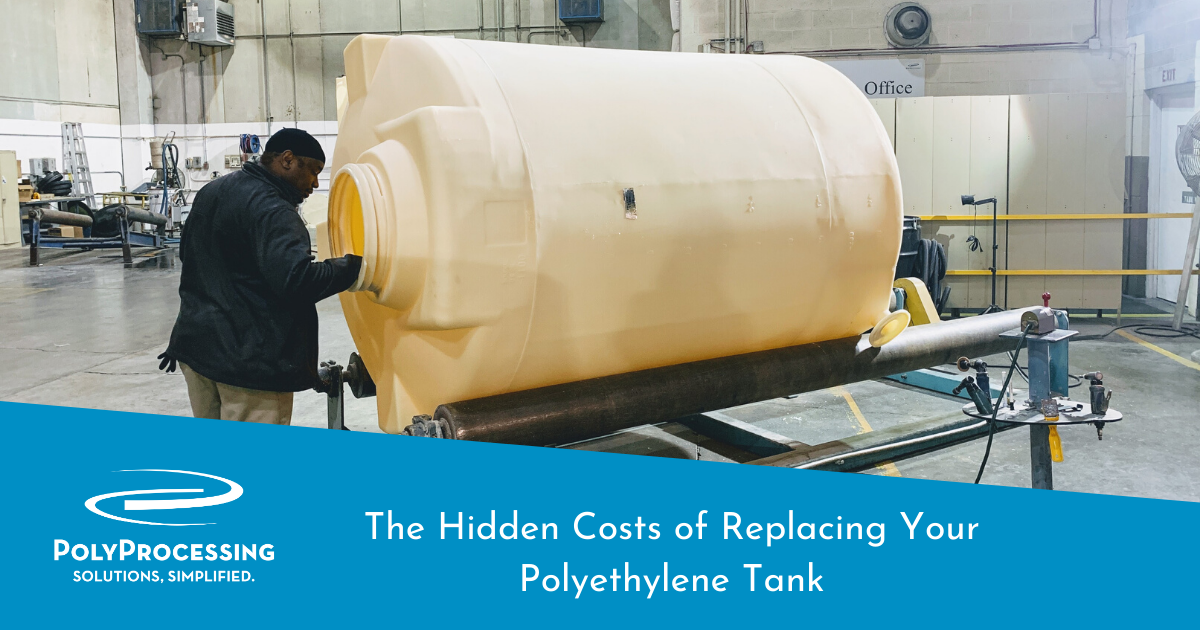The Hidden Costs of Replacing Your Polyethylene Tank
How do you know when it’s time to replace your polyethylene storage tank, instead of repairing it? No matter what chemical tank manufacturer you use, there are hidden costs to replacing a damaged tank. At some point, it’s less expensive to replace the tank — but that could be years later than you might think.

Many companies only calculate the tank purchase cost and shipping costs when deciding whether to repair or replace a chemical storage tank, but there are several additional factors to consider as well. Let’s look at these overlooked factors that contribute to your total cost.
The Cost of Plastic Tank Repair Service
In general, repairing a chemical tank has fewer hidden costs than replacing it, but you should still be aware of them. Your tank manufacturer is likely to charge you for these expenses:
- Travel costs, including mileage or airfare
- Travel time, if the travel is not local
- Hourly time for onsite inspection and repair work
- Parts not under warranty. Poly Processing’s tanks are warranted for five years in general, but fittings are under warranty for 90 days. If your tank or the fittings aren’t under warranty, then manufacturers will expect you to cover the cost of those parts.
Your downtime will be an indirect cost to you, as well. In almost all cases, you will need to drain and clean the tank before we can work on it. You will also need to move the remaining chemical to a tanker truck, another tank, or lose the contents of the damaged tank.
The Costs of Replacing a Polyethylene Tank
The cost of replacing a tank can be much higher than the price of the tank alone, especially if you don’t purchase the right tank with the right installation. But if you work with chemical storage experts during the purchasing process, we can help you plan strategically so any future replacement costs are kept to a minimum.
These factors can add to your tank replacement costs:
Temporary day tank
If you need the chemical on a daily basis, you should bring in a temporary tank while the new one is being manufactured and shipped. Often, you can purchase a smaller polyethylene tank as a temporary tank.
We have good relationships with several rental companies. If you’re going to be without a tank for a time and need a backup tank, we can connect you to a good and reliable source.
Backup tank
We often see facilities that purchase very large FRP tanks for their chemical storage system, instead of breaking the system down into more manageable sizes. However, we often recommend purchasing a backup storage tank as well, to ensure that you have redundancy. This may include splitting the needed gallonage into two tanks instead of one large tank. If a failure occurs, you’ll still have a tank online so that you can continue operations while the issue is resolved.
Tank removal
Getting the old tank out of the building can be a large undertaking. A crew will need to disconnect the piping, pumps, and other accessories. The tank will need to be pulled out of the building—or, if it’s too large to pull through the doors, it will need to be cut up and removed.
Installing the new tank
If the new tank is too large to maneuver through the entrances, you may need to remove the paneling or roofing, and lift the new tank inside the building with a crane.
Each of these factors raise the cost of chemical tank replacement. Be sure to consider each of them before committing to a course of action.
Should You Repair or Replace Your Tank?
Usually, repairing a tank is less expensive than replacing it. But just because you can repair a tank, that doesn’t mean you should repair it. Poly Processing has experts who can help you weigh the advantages and disadvantages of repairing your chemical storage tank.
Our factory-certified experts can come out and inspect your tanks onsite. Once we’ve investigated the problem, we’ll look at the repair options and determine how well it’s going to hold up, versus the cost of replacing a tank.
If a patch will only last for a short time, you’re probably better off in the long run by investing in a replacement tank. We’ll give you an honest and dependable recommendation that supports your overall business and financial needs. The goal is employee safety and your peace of mind.
Do It Right the First Time
Replacing a tank can be an expensive venture, but if you plan ahead you can keep your costs down. The Poly Processing Installation, Operation, and Maintenance Manual helps you think strategically about most aspects of tank installation, including where you should be placing your tanks in your facility. Proper planning is critical to the overall success and longevity of your tank, and your overall costs.
The installation guide also includes an inspection checklist that outlines some of the things to look for during yearly tank inspections.
Be sure you buy the right tank, with the right installation. Have conversations ahead of time with Poly Processing, the contractor, and the distributor about where the tank will be placed. All of these factors impact your expenses if there’s a tank failure.
Need a chemical tank repair or replacement? Talk to one of our storage tank experts today.
- September 30, 2024
- Topics: Value Added
About Poly Processing
Posts By Topic
Tech Talk Podcast Episodes
Subscribe By Email
Recent Posts
- Changing Chemical Storage in HDXLPE Tanks: An Introductory Overview to Safe Chemical Transitions
- The Largest Crosslinked True Full Discharge Tanks Available: 15,500 IMFO and 15,000 Sloped Bottom IMFO
- Contained Bottom Discharge for Double-Wall Tank
- Join Us at WEFTEC 2025 Conference & Exhibition
- Effective Wastewater Treatment Chemical Storage
Tank Configurator

Find the recommended tank and system components for your chemical storage challenge.
Configure a Tank Package







